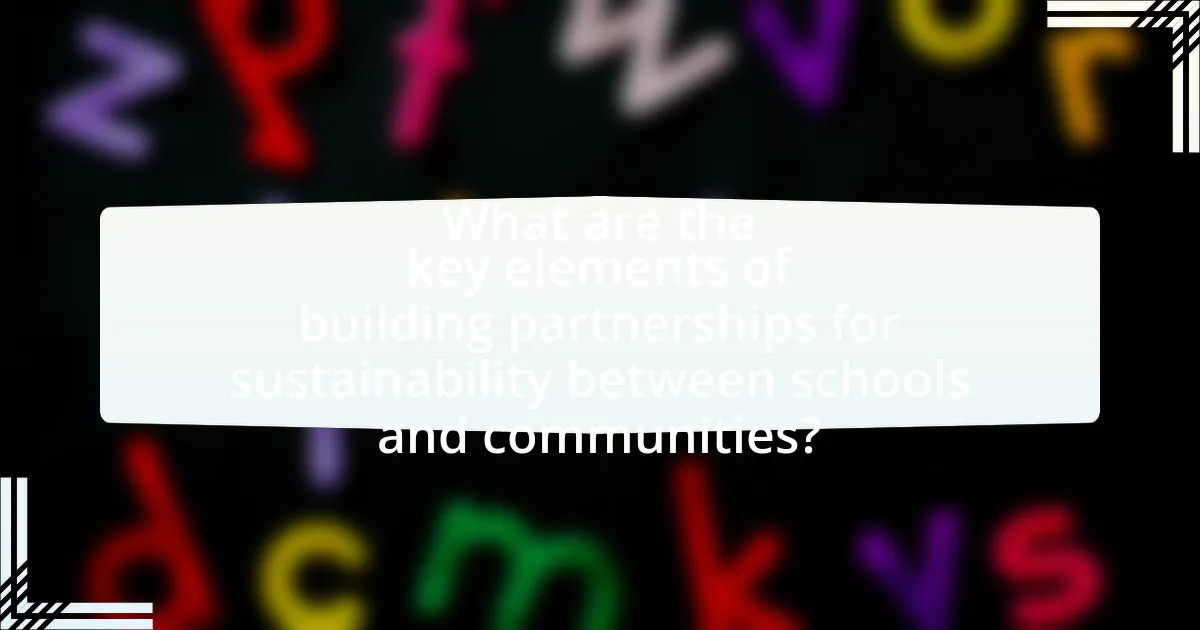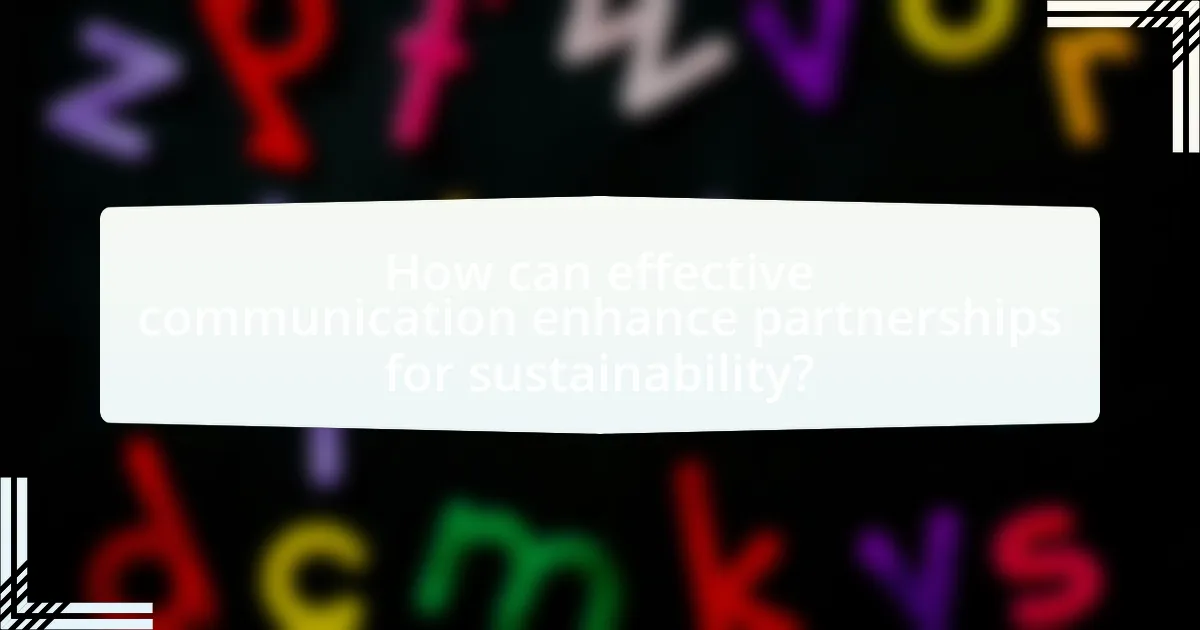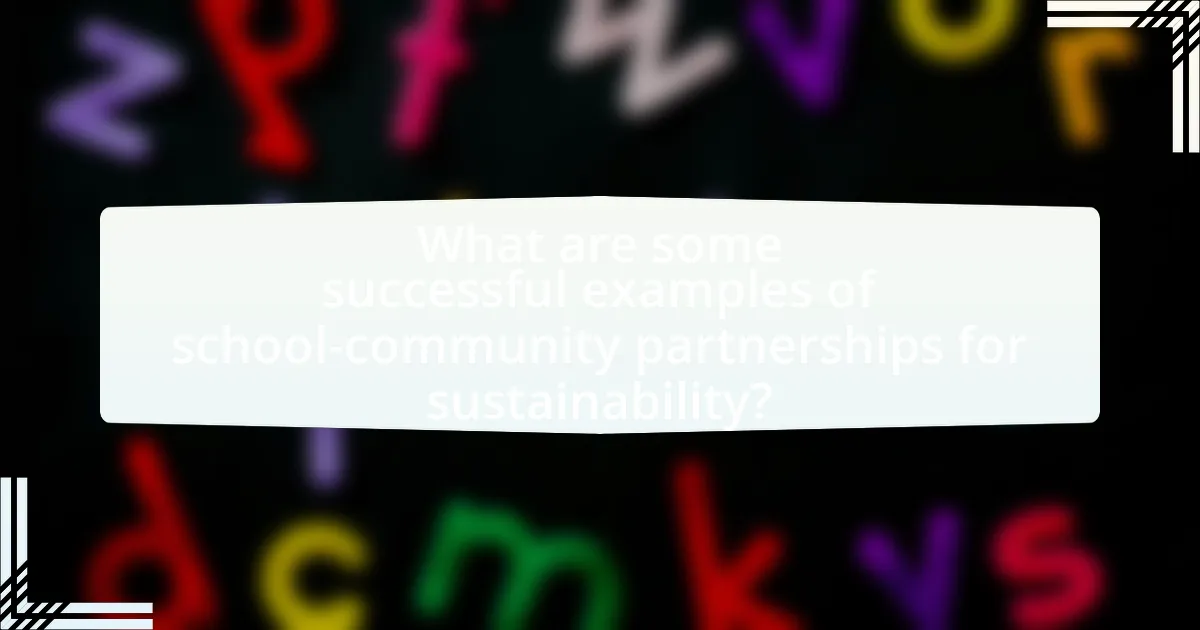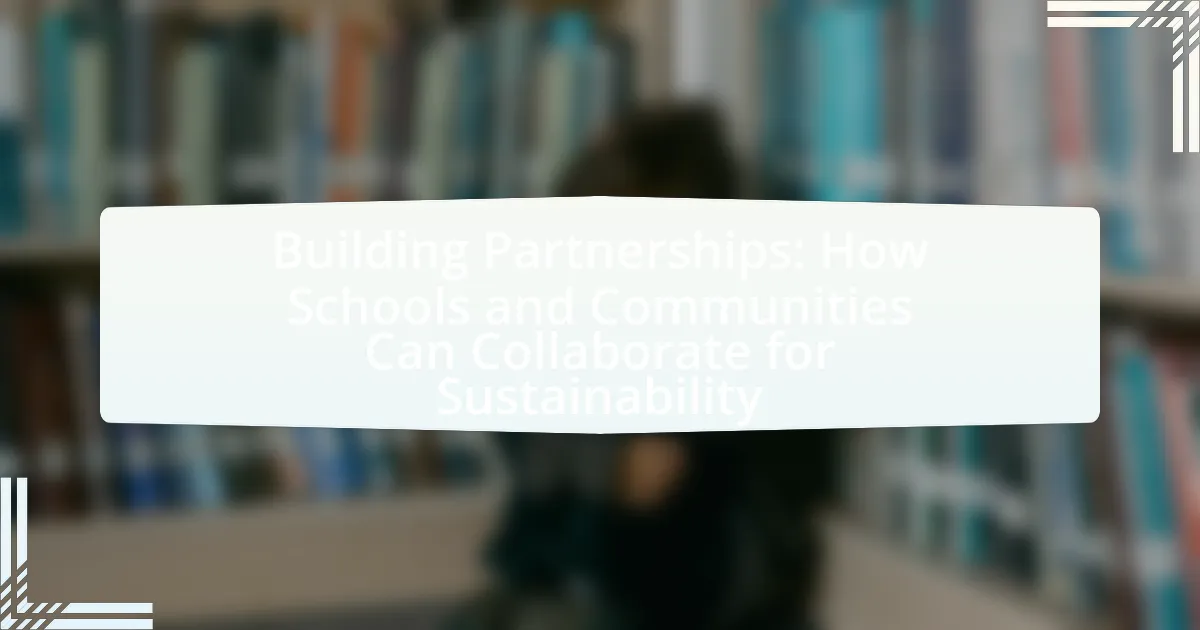The article focuses on building partnerships for sustainability between schools and communities, emphasizing key elements such as shared goals, effective communication, mutual respect, and resource sharing. It outlines strategies for schools to identify potential community partners, evaluate them based on alignment with educational goals, and approach organizations to initiate collaborations. The roles of schools and communities in sustainability efforts are discussed, along with the benefits of collaboration, including enhanced educational outcomes and environmental impacts. Successful case studies, best practices, and resources for developing these partnerships are also highlighted, providing a comprehensive framework for fostering sustainable initiatives in educational settings.

What are the key elements of building partnerships for sustainability between schools and communities?
The key elements of building partnerships for sustainability between schools and communities include shared goals, effective communication, mutual respect, and resource sharing. Shared goals ensure that both schools and communities work towards common sustainability objectives, such as reducing waste or promoting environmental education. Effective communication fosters transparency and collaboration, allowing both parties to express their needs and expectations clearly. Mutual respect builds trust, which is essential for long-term partnerships, while resource sharing, including knowledge, funding, and facilities, enhances the capacity of both schools and communities to implement sustainable practices. These elements are supported by successful case studies, such as the Green Schools initiative, which demonstrates how collaborative efforts can lead to significant environmental and educational benefits.
How can schools identify potential community partners for sustainability initiatives?
Schools can identify potential community partners for sustainability initiatives by conducting a thorough assessment of local organizations, businesses, and government entities that align with sustainability goals. This can involve researching community resources, attending local events, and engaging in networking opportunities to discover partners with shared interests in environmental stewardship. For instance, schools can utilize platforms like the National Environmental Education Foundation, which provides resources for connecting with local environmental organizations. Additionally, schools can analyze existing partnerships in their area to identify successful collaborations that could serve as models.
What criteria should schools use to evaluate potential partners?
Schools should evaluate potential partners based on alignment with educational goals, resource availability, and community impact. Alignment with educational goals ensures that the partnership supports the curriculum and enhances student learning outcomes. Resource availability assesses whether the partner can provide necessary materials, expertise, or funding to support school initiatives. Community impact evaluates how the partnership benefits the local community, fostering a sense of collaboration and shared responsibility for sustainability. These criteria help schools select partners that contribute positively to their mission and the broader community.
How can schools approach community organizations to initiate partnerships?
Schools can approach community organizations to initiate partnerships by identifying shared goals and mutual benefits. This involves conducting research to understand the community’s needs and the resources available within local organizations. Schools should then reach out through formal communication, such as letters or emails, outlining their objectives and proposing specific collaboration opportunities. Evidence shows that partnerships can enhance educational outcomes; for instance, a study by the National Education Association found that schools with community partnerships reported improved student engagement and academic performance. By presenting data and success stories, schools can effectively demonstrate the value of collaboration to potential partners.
What roles do schools and communities play in sustainability partnerships?
Schools and communities play crucial roles in sustainability partnerships by fostering education, engagement, and resource sharing. Schools serve as educational hubs, teaching students about sustainability practices and encouraging environmentally responsible behaviors. For instance, programs like Eco-Schools have demonstrated that integrating sustainability into the curriculum can lead to increased awareness and action among students. Communities, on the other hand, provide real-world contexts for these lessons, offering opportunities for students to participate in local sustainability initiatives, such as community gardens or recycling programs. Research shows that when schools collaborate with local organizations, such as environmental nonprofits, they can enhance the effectiveness of sustainability efforts, leading to measurable improvements in community environmental health.
How can schools contribute to community sustainability efforts?
Schools can contribute to community sustainability efforts by implementing educational programs focused on environmental stewardship and engaging students in local sustainability projects. For instance, schools can integrate sustainability into their curricula, teaching students about renewable energy, waste reduction, and conservation practices. Research shows that schools that participate in programs like Eco-Schools or Green Schools not only enhance student awareness but also foster community involvement in sustainability initiatives. Additionally, schools can serve as community hubs for sustainability events, such as tree planting or recycling drives, thereby promoting collective action and awareness among families and local residents.
What resources can communities provide to support school sustainability initiatives?
Communities can provide financial support, volunteer labor, educational resources, and partnerships with local businesses to support school sustainability initiatives. Financial support can come in the form of grants or fundraising efforts, which enable schools to implement eco-friendly projects. Volunteer labor from community members can assist in hands-on activities like gardening or clean-up events, fostering a sense of ownership and collaboration. Educational resources, such as workshops or materials from local environmental organizations, can enhance students’ understanding of sustainability practices. Additionally, partnerships with local businesses can lead to sponsorships or donations of materials, further bolstering the initiatives. These resources collectively enhance the capacity of schools to pursue sustainability goals effectively.
What are the benefits of collaboration between schools and communities for sustainability?
Collaboration between schools and communities for sustainability enhances educational outcomes and fosters environmental stewardship. Schools gain access to community resources, expertise, and real-world experiences that enrich the curriculum, making sustainability concepts more tangible for students. For instance, partnerships can lead to hands-on projects like community gardens or recycling initiatives, which not only educate students but also engage the community in sustainable practices. Research indicates that such collaborations can improve student engagement and academic performance, as seen in the “Learning in Places” initiative, which demonstrated increased student interest in environmental science through community-based projects. Additionally, these partnerships can strengthen community ties, promote shared values around sustainability, and mobilize collective action towards local environmental goals.
How does collaboration enhance educational outcomes for students?
Collaboration enhances educational outcomes for students by fostering a supportive learning environment that promotes engagement and critical thinking. When students work together, they develop essential skills such as communication, teamwork, and problem-solving, which are crucial for academic success. Research indicates that collaborative learning can lead to higher achievement levels; for instance, a study published in the “Journal of Educational Psychology” found that students who participated in collaborative learning activities scored significantly higher on assessments compared to those who learned individually. This improvement is attributed to the exchange of diverse perspectives and ideas, which deepens understanding and retention of knowledge.
What environmental impacts can be achieved through these partnerships?
Partnerships between schools and communities can lead to significant environmental impacts, including enhanced biodiversity, reduced carbon footprints, and improved waste management. For instance, collaborative initiatives such as community gardens and tree planting programs not only promote local flora and fauna but also contribute to carbon sequestration, thereby mitigating climate change. Research indicates that urban greening projects can reduce urban heat islands by up to 5 degrees Celsius, demonstrating the tangible benefits of such partnerships. Additionally, educational programs focused on sustainability can lead to increased recycling rates and reduced landfill waste, as communities become more aware of their environmental responsibilities.

How can effective communication enhance partnerships for sustainability?
Effective communication enhances partnerships for sustainability by fostering trust, clarity, and collaboration among stakeholders. When schools and communities engage in open dialogue, they can share resources, align goals, and address challenges more effectively. Research indicates that effective communication strategies, such as regular meetings and transparent information sharing, lead to increased participation and commitment from all parties involved. For instance, a study by the National Environmental Education Foundation found that communities with strong communication networks are 30% more likely to implement sustainable practices successfully. This demonstrates that clear communication is essential for building and maintaining effective partnerships aimed at sustainability.
What strategies can schools and communities use to communicate effectively?
Schools and communities can communicate effectively by implementing regular meetings, utilizing digital platforms, and fostering open dialogue. Regular meetings, such as town halls or school board sessions, allow stakeholders to share updates and address concerns, enhancing transparency and trust. Digital platforms, including social media and dedicated websites, facilitate timely information dissemination and engagement, reaching a broader audience. Open dialogue encourages feedback and collaboration, ensuring that all voices are heard and valued. Research indicates that effective communication strategies lead to improved community involvement and student outcomes, as seen in studies conducted by the National School Public Relations Association, which highlight the correlation between strong communication practices and enhanced educational environments.
How can technology facilitate communication between partners?
Technology facilitates communication between partners by providing various platforms and tools that enhance interaction and collaboration. For instance, video conferencing applications like Zoom and Microsoft Teams enable real-time discussions, allowing partners to connect regardless of geographical barriers. Additionally, project management tools such as Trello and Asana streamline task assignments and progress tracking, ensuring that all partners are aligned on objectives and deadlines. Research indicates that effective communication through technology can lead to improved partnership outcomes, as evidenced by a study published in the Journal of Business Communication, which found that organizations utilizing digital communication tools reported a 30% increase in collaborative efficiency.
What role does transparency play in building trust among partners?
Transparency is essential in building trust among partners as it fosters open communication and accountability. When partners share information openly, it reduces misunderstandings and aligns expectations, which is crucial for effective collaboration. Research indicates that organizations with high transparency levels experience increased trust and cooperation, leading to more successful partnerships. For instance, a study by the Harvard Business Review found that transparency in decision-making processes significantly enhances trust among stakeholders, thereby improving partnership outcomes.
How can schools and communities share successes and challenges in sustainability efforts?
Schools and communities can share successes and challenges in sustainability efforts through collaborative platforms such as community forums, social media groups, and joint sustainability events. These platforms facilitate open communication, allowing stakeholders to discuss best practices, share data on outcomes, and address obstacles encountered in their initiatives. For instance, the National Wildlife Federation’s Eco-Schools program encourages schools to connect with local communities, providing a structured approach to share experiences and resources. This collaboration not only enhances transparency but also fosters a sense of shared responsibility, leading to more effective sustainability practices.
What platforms can be used for sharing information and experiences?
Platforms that can be used for sharing information and experiences include social media networks, online forums, blogs, and collaborative tools. Social media networks like Facebook and Twitter facilitate real-time communication and sharing of experiences among users. Online forums such as Reddit and specialized community boards allow for in-depth discussions and exchange of ideas. Blogs provide a platform for individuals and organizations to share detailed narratives and insights. Collaborative tools like Google Drive and Microsoft Teams enable groups to work together, share documents, and communicate effectively. These platforms are widely recognized for their ability to connect individuals and foster community engagement, particularly in initiatives related to sustainability.
How can feedback mechanisms improve partnership effectiveness?
Feedback mechanisms can improve partnership effectiveness by facilitating open communication and continuous improvement among partners. These mechanisms allow stakeholders to share insights, assess progress, and identify areas for enhancement, which leads to more aligned goals and strategies. For instance, regular feedback sessions can help partners understand each other’s needs and expectations, fostering trust and collaboration. Research indicates that organizations utilizing structured feedback processes experience a 25% increase in project success rates, demonstrating the tangible benefits of effective communication in partnerships.

What are some successful examples of school-community partnerships for sustainability?
Successful examples of school-community partnerships for sustainability include the Green Schools Initiative in California, which engages schools in environmental education and sustainable practices, and the Eco-Schools program, which operates globally to promote sustainability in schools through community involvement. The Green Schools Initiative has led to significant reductions in waste and energy use in participating schools, demonstrating measurable impacts on sustainability. Similarly, the Eco-Schools program has resulted in over 60,000 schools worldwide adopting sustainable practices, showcasing the effectiveness of community collaboration in fostering environmental stewardship.
What case studies illustrate effective collaboration for sustainability?
Case studies illustrating effective collaboration for sustainability include the Green Schools Initiative in California, where schools partnered with local governments and organizations to implement energy-efficient practices, resulting in a 20% reduction in energy use. Another example is the Eco-Schools program, which engages students, teachers, and communities in sustainability projects, leading to improved environmental awareness and community involvement. Additionally, the Sustainable Schools Project in New Zealand showcases collaboration between schools and local iwi (Māori tribes) to integrate indigenous knowledge into environmental education, fostering a sense of stewardship among students. These case studies demonstrate the impact of collaborative efforts in promoting sustainability within educational settings and communities.
What lessons can be learned from these successful partnerships?
Successful partnerships between schools and communities demonstrate the importance of collaboration, shared goals, and mutual benefits. These partnerships reveal that aligning educational objectives with community needs fosters sustainable practices, as seen in initiatives where schools implement local environmental projects that engage students and benefit the community. For instance, a study by the National Education Association highlights that schools collaborating with local organizations can enhance student learning outcomes while addressing community challenges, such as waste reduction and resource conservation. This evidence underscores that effective communication and commitment from all stakeholders are crucial for achieving long-term sustainability goals.
How can these examples inspire new initiatives in other communities?
These examples can inspire new initiatives in other communities by demonstrating effective collaboration strategies between schools and local organizations. For instance, successful partnerships often lead to shared resources, enhanced educational programs, and increased community engagement, as seen in case studies where schools implemented sustainability projects with local businesses. Research indicates that communities that foster such collaborations experience improved environmental outcomes and stronger social ties, as evidenced by the 2019 study published in the Journal of Environmental Education, which highlighted that schools involved in community sustainability initiatives reported a 30% increase in student participation and awareness. By replicating these models, other communities can cultivate similar partnerships that drive sustainable practices and educational growth.
What best practices should schools and communities follow when forming partnerships?
Schools and communities should prioritize clear communication and shared goals when forming partnerships. Establishing open lines of communication ensures that all stakeholders understand each other’s needs and expectations, fostering trust and collaboration. Additionally, aligning on common objectives allows both parties to work towards a unified vision, enhancing the effectiveness of their efforts. Research indicates that partnerships with defined goals are more likely to succeed; for instance, a study by the National Education Association found that collaborative initiatives with shared objectives lead to improved student outcomes and community engagement.
How can schools ensure long-term sustainability of partnerships?
Schools can ensure long-term sustainability of partnerships by establishing clear communication channels and shared goals with their partners. Effective communication fosters trust and collaboration, while aligning objectives ensures that all parties are working towards common outcomes. Research indicates that partnerships with defined roles and responsibilities are more likely to succeed; for instance, a study by the National Education Association found that schools with structured partnership frameworks reported higher levels of engagement and resource sharing. Additionally, regular evaluation and feedback mechanisms can help adapt and strengthen partnerships over time, ensuring they remain relevant and beneficial to all stakeholders involved.
What common pitfalls should be avoided in partnership development?
Common pitfalls to avoid in partnership development include lack of clear communication, misaligned goals, and insufficient stakeholder engagement. Clear communication is essential; without it, misunderstandings can arise, leading to conflicts and inefficiencies. Misaligned goals can result in partners pursuing different objectives, which undermines the partnership’s effectiveness. Insufficient stakeholder engagement often leads to a lack of buy-in and support, making it difficult to implement initiatives successfully. Research indicates that partnerships with clearly defined roles and open lines of communication are more likely to succeed, as evidenced by case studies in community development projects.
What practical steps can schools take to initiate partnerships for sustainability?
Schools can initiate partnerships for sustainability by identifying local organizations and stakeholders that share similar environmental goals. This involves conducting outreach to community groups, businesses, and governmental agencies focused on sustainability initiatives. For example, schools can collaborate with local environmental nonprofits to develop joint programs, such as recycling drives or community gardens, which not only enhance educational experiences but also foster community engagement. Research indicates that schools that engage in partnerships with local organizations see increased student participation in sustainability efforts, as evidenced by a study from the National Wildlife Federation, which found that schools involved in community partnerships reported a 30% increase in student-led environmental projects.
How can schools create a partnership action plan?
Schools can create a partnership action plan by first identifying key stakeholders, including parents, local businesses, and community organizations. Next, they should establish clear goals for the partnership, such as enhancing educational resources or promoting sustainability initiatives. Following this, schools must develop specific strategies and activities that align with these goals, ensuring that roles and responsibilities are clearly defined among partners. Finally, schools should implement a system for monitoring progress and evaluating the effectiveness of the partnership, allowing for adjustments as needed. Research indicates that effective partnerships can lead to improved student outcomes and community engagement, as demonstrated by the National Network of Partnership Schools, which highlights successful collaboration models.
What resources are available to support schools in building these partnerships?
Schools can access various resources to support the development of partnerships with communities for sustainability. These resources include grants from organizations such as the U.S. Department of Education, which offers funding opportunities specifically aimed at fostering community engagement in educational settings. Additionally, non-profit organizations like the National Education Association provide toolkits and guidelines for effective collaboration between schools and local entities. Research studies, such as those published by the Center for American Progress, highlight successful case studies and best practices in school-community partnerships, offering concrete examples for schools to emulate. Furthermore, online platforms and networks, such as the Coalition for Community Schools, facilitate connections between schools and community organizations, enhancing collaboration efforts.

Leave a Reply